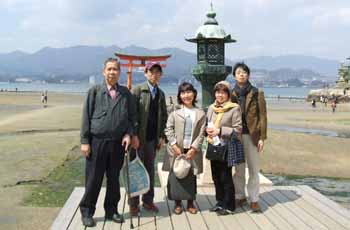Group Introduction Citizen Science Initiative Japan Exposure to Low Level Radiation Research Group Nuke Info Tokyo No. 138
By Mikiko Watanabe*
 |
|
Members of Exposure to Low Level Radiation Research Group (Yukuo Sasamoto left)
(Photo taken at Miyajima, Hiroshima by Mariko Shinoda) |
I am a member of the Exposure to Low Level Radiation Research Group. The Research Group is now working on the history of surveys of the damage caused by the atomic bombing 65 years ago of Hiroshima and Nagasaki. As part of our study, members of the Research Group visited Hiroshima from March 21 to 24, 2009.
We carried out a document study and visited sites connected with a-bomb surveys. By actually seeing these sites, we were able to gain a shared sense of the geography and other things that cannot be obtained from documents alone. We hoped that our shared experiences would inject more vigor into the Research Group‘s future discussions. Since then we have carried forward our study through regular monthly meetings, putting the experiences of our fieldwork trip to good use and sharing documents that we have found.
The basis for the study is a book entitled Atomic Bomb Studies Under the US Military Occupation (Beigun Senryo-ka no Gembaku Chosa, Shinkansha, 1995) written by one of our members Yukuo Sasamoto. We are particularly conscious of the perspective expressed in the book’s subtitle, “Japan – inflictor of atomic damage”. The Japanese Government carried out surveys immediately after the atomic bombings, but the question is, did these surveys really benefit the victims? Sasamoto says that it is not enough to simply say that the results of these surveys were seized by the US military. Rather, he believes we must consider the peculiar situation in which the victim country, Japan, was conducting surveys of the damage caused by the atomic bombs under the nose of the occupying forces of the country which dropped these weapons of mass destruction. Apparently the occupying forces condoned this research. The implication of the subtitle of Sasamoto’s book is that by conducting these surveys, which had nothing to do with helping the victims, Japan became an accomplice.
We lost a great pillar of our project when Sasamoto died suddenly in March this year. However, the members of the Research Group continue to work on the remaining issues. We want to carry on the work where he left off.
We are now working to bring together all the material, interpreting the meaning of each individual document, while keeping an eye on the overall picture. In addition to material collected by Sasamoto, we have gathered communications related to internal surveys by the US occupying forces (GHQ/SCAP documents), orders by the Japanese Government and the Army and Navy found among documents in the National Archives of Japan and the Diplomatic Records Office of the Ministry of Foreign Affairs, writings of people directly connected with a-bomb surveys, as well as newspaper articles.
We believe that by revealing the involvement of Japanese government, military and academics in the a-bomb surveys of the US Government and military our study reinforces Sasamoto’s work.
In addition to our study of the history of a-bomb surveys, we also held two citizen science seminars. In one session we used the NHK documentary The Lost Decade Survivors of Atomic Bomb as a basis for addressing the question “Who were the Japan-US joint atomic bomb studies for?” In another we viewed a documentary about science during the war, Resurrecting the Kyoto University Cyclotron (Yomigaeru Kyodai Cyclotron).
*Mikiko Watanabe is CNIC’s radiation campaigner and editor of our Japanese newsletter.
